2004 VOLKSWAGEN GOLF PLUS ESP
[x] Cancel search: ESPPage 194 of 541

Brake booster
Th e brak e boo ste r w ork s o
nly wh en the engi ne is
running . It increa se s th e forc e on the brake s above and beyond the pre ssure put on th e brake pedal by
the driver.
If the brake booster is not working, or if th e ve hicl e
ha s to be towed, you have to push th e brak e
p ed a l hard er to make up for the lack of booster
New brake pads do not provide maximum braking performance.
New brake pads do not have the best ping power for the first km) and must be You can compensate for the slightl y reduced braking force by putting more pressure on the brake pedal.
Drive with
Never follow otl1er vehicles too closely or put yourself into other sit uation s that might require sudden, hard braking ,especially when the brake pads have not been broken
Overheated brakes
When driving downhill , the brakes have to
work es pecially hard and heat up quickly.
Before driving downhill, es peciall y on th at are long or steep, alwa ys reduce s peed and shift into lower gear (manual or automatic
transmission) so that the engine he lp s to brake
the vehicl e. Othenvise, the brake system cou ld
ov erheat and pos sibly u se the brakes
w hen yo u need them to slow the v ehicl e down
m ore or to stop.
A damaged front spoiler or a non- standard spoiler can reduce airflow to the brakes and
Starting, shifting, parking
Wet brakes or brakes witl1 icc or road salt
react slow er and n eed lo n ger stoppin g tances.
Ca refully apply the brakes to test th em.
Always dry brak es and clean off ice and salt
coat ings with a few cautious
tions permit.
Driving when the booster is no t working
in creases stopping distances and can cause dent s and seriou s personal injuries.
Never le t the vehicl e coast when the en gine is
switc hed off.
If the brake booster is not working (such as
w he n the vehicle is bein g towed), a lot more pedal force is needed to slow down and stop.
Note
Neve r the by keeping your foot on the to brak e.
Constant pressure on the brake pedal can make th e brakes overheat. This sub stantially reduce
braking performance, increase stopping di stan ce, and can cause co mpl ete failure of th e brake
s y stem.
Before driving downhill, especially on that are long or steep, always reduce speed and shift into lower gear (manua l or automati c
When th e front brake s are serviced , you should have the rea r brake pads inspected
rized Volksw agen deal er or au th orize d Volkswa gen
Service Facility vis uall y insp ec t th e pads through
th e o pe nin gs in the wh eel rim s or from nea th tl1e ve hicle. If n ecess ary, the wheels ca n be
t ake n off for a mor e thorou gh
192 193
Page 201 of 541
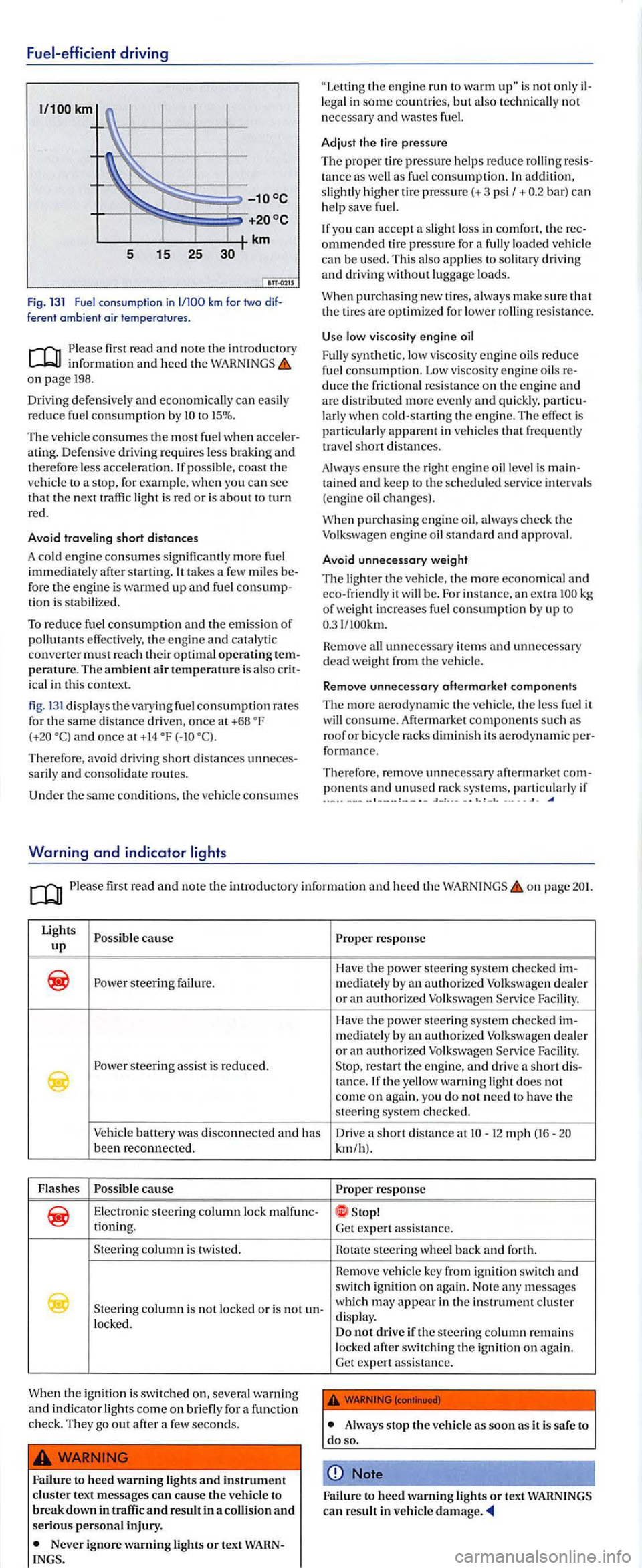
Fuel-efficient driving
Fig. 131 Fuel consumption in ferent ambient air temperatures .
info rmation and heed the on page 198.
Dri vin g defensive ly and economically can easily
r educe fuel con sumption by to 15 % .
The ve hicle consu mes the most fu el w he n atin g. D efe nsive dri vin g require s less brakin g and therefore less accelerat ion. If possib le, coast the ve hicle to a sto p, for exa mple, when yo u ca n see th a t th e next traffic ligh t is red or is about to turn
red.
Avoid traveling short distanc
es
A cold engine consumes sig nificantl y more fuel
imm ediately after sta rtin g. It take s a few miles fore the engi ne is warm ed up and fuel tion i s stabili zed.
To reduce fuel consumptio n and the emission of pollutants effect ive ly, the e ng in e and ca talytic
conve rter must reach th eir optimal operating
ica l in thi s context.
fig. 13 1 displays the v a ry ing fuel consumption rates
for the same d istance dri ven, once at +68 and once at + 14
th e e ngin e run to warm is not o nl y lega l in some co untries, but also technicall y not
n ecessary and wastes fu el.
Adjust the tire pres sure
T he prop er tir e
pressure help s reduce rollin g tance as well as fue l co nsumption. In additi on ,
slig htl y higher tire pressure(+ 3 psi I+ bar) ca n
h e lp save fuel.
If you ca n a ccept a slight los s in comfort, the ommend ed tir e pressure for a fully loade d ve hicl e
ca n be used. This als o applies to so litary dri vin g and driv ing withou t lu ggage loa ds.
When purchasing new t ires, alway s ma ke sure th at
th e tires are optimi zed for lower rollin g resis tance.
Us e low viscosity engine oil
F ull y sy nth e
tic, low viscosity e ngine oils reduce
fuel consumption. Low viscosity e ngin e oils duce the fric tional res istance on th e engine and are dis tributed m ore evenly and qui ckly, larly w hen co ld -s tarting the engine. The effect is parti c ularl y apparent in vehicles th at frequentl y
tra vel s hort dis tan ces.
A lways ens
ure th e righ t e n g in e oil leve l is ta in ed and keep to the sc h edul ed serv ice interva ls
(e ng ine oil ch an ges).
W
hen purch asing e ngine oil, always ch eck th e Volksw agen en gine oil standard and approval.
Avoid unnecessary weight
The lighter th e ve hicl e, th e more economica l and ceo-friend ly it w ill be. For in stance, an extra
H e m ove
consum e. Aftermark et co mponents s uch as
ro of or b icycle racks dimin is h its aerod yn a m ic fonnan ce.
Th erefo re, re
mov e un necessary aftermark e t ponents and unused rac k systems, parti cul arly if ....... -
fir st read and note th e introductory informa tion and h ee d th e WAHNINGS page
response
Ha ve the power stee rin g sys te m ch ec ked ste eri ng failure. mediatel y by an authori zed Volk swag en deale r
o r a n authorized Volk swagen
Fac ility. steeri ng ass is t i s reduced. re start the e n gine, and dri ve a sh ort tan ce. If th e yello w warning light does not
c o m e on again, you do not need to have th e
s te ering syste m ch ec ke d .
Vehicle battery was di sconnected and has Drive a short distan ce at 12 mph been reconnec te d . km/h).
F lashes re sponse
Elec troni c steering column lo ck malfunc -
which m ay appea r in the in strument clu ste r
di sp lay. loc ke d.
W
hen the i g nit ion is switc h ed on, seve ra l wa rnin g and indicator lights come on bri efly for a f un ction ch e ck . T hey go out after a few seconds.
Failure to
heed warning light s and in strument cluster text m essages can cause th e vehicl e to break down in t raffic and result in a collisio n and seriou s personal injury.
Neve r igno re warning lights or tex t
Do not dri ve if th e s teerin g co lumn remains
l ocke d switch in g th e ig niti on on aga in.
Ge t expert assis ta nce.
Alwa ys sto p the vehicl e as soon as it is safe to do so .
Note
Failur e to heed warning lights or tex t WARNINGS can res ult in vehicl e damage
Page 208 of 541
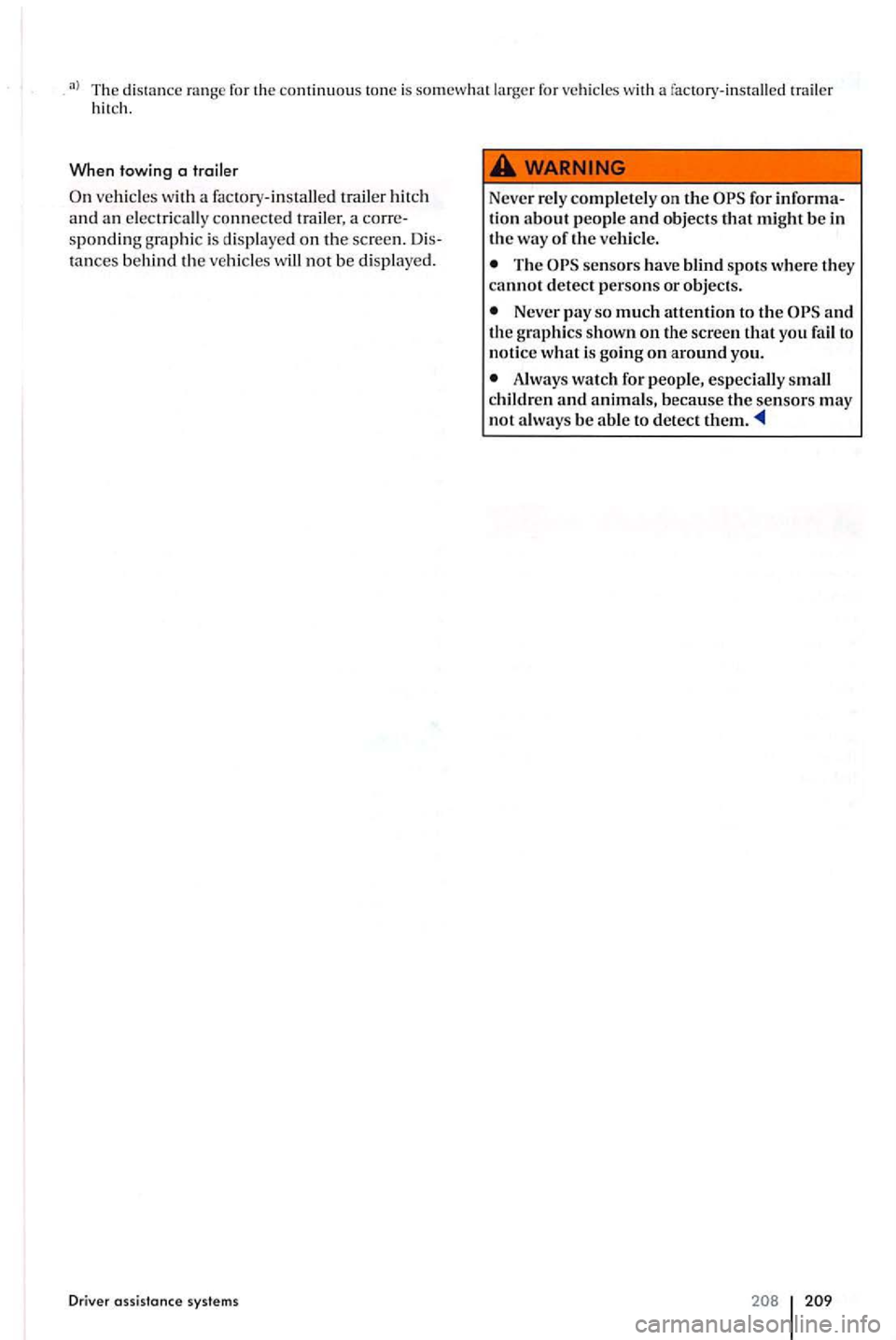
The
vehicl es with a factory-installed trailer hitch
a nd an elec trically co nn ected a corre
s p ondin g grap hic is displayed on th e sc reen. Dis
tan ces behind the vehicl es will not be displayed.
Drive r assis tance systems
Never rely completely on the
The sensors have blind spots where they
cannot detect persons or objects.
Never pay so much attention to the and the graph ics shown on the screen that you fail to notice what is go ing on around you.
Always watch for people, especially s mall
children and animals, because tl1e sensors may
not always be able to detect t11em.
208 209
Page 209 of 541
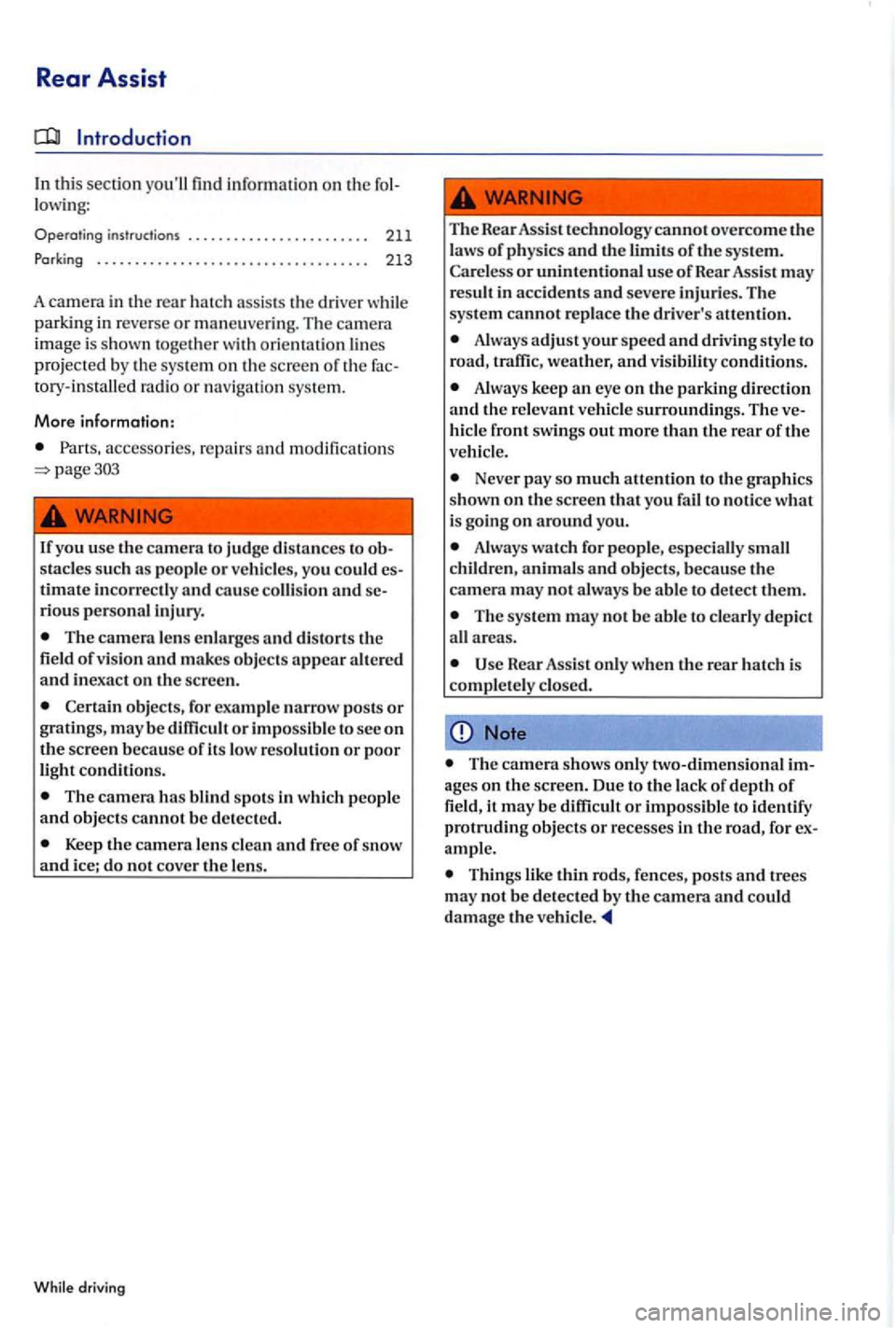
Rear Assist
In thi s sec tion you'll find on th e lowing :
Operating instru ctions . . . .. . . . .. . . . .. . . . . . . .. . 211
Par king . . . . . . . . . . . . . . . . . . . . . . . . . . . . . . . . . . . .
213
A camera in the rear hat ch assis ts th e driver parkin g in reve rse or maneu ve ring. Th e ca mera
image i s s how n with orientati on lines proj ecte d by th e sys te m on th e screen of th e tory-in stall ed radio or na vigatio n sys tem .
More information:
Parts, accessories, repai rs and modifi cation s
If you use the ca mera to judge distances to stacles such as people or vehicles, you could timate inc orre ctl y and cause colli sion and riou s personal injury.
The camera lens enlarg es and distort s th e
field of vision and makes object s appear altered and in exact on the screen.
C ertain objects , for exa mpl e narrow posts or gratings , m ay be diffi cult or impo ssible to see on the scree n becaus e of its low resolution or poor light condition s.
The camera has blind spots in which people and objects cannot be dete cted .
Keep the camera len s clean and fr ee of snow and ice; do not cove r the le n s.
driving
The Rear Assist technology cannot overcome the law s of physics and the limit s of the system. Care less or unintentional use of Rear Assist may
re sult in accidents and seve re injuri es. The
sys te m ca
nnot repla ce the driver's attention.
Always adjust your speed and dri ving style to
road, traffic , weather, and visibility conditions.
Always keep an eye on the parking direction and the relevant vehicl e surrounding s. The
Never pay so much attention to the graphics
s hown on th e screen that yo u fail to notic e what is going on around you.
Always watch for peop le, especi ally small
children, animals and o bject s, because the cam era may not a lways be able to detect the m .
The sys tem may not be able to clearly depict
all areas.
Use Rear Ass is t only when the rear hatch is
completely closed.
Note
The camera shows only two-dimensiona l ages on the scree n. Du e to the lack of depth of field, it may be diffi cult or impossible to identify
protrudin g object s or recesses in the road, for ample.
Thing s lik e thin rods, fence s, pos ts and t rees may not be dete cted by the cam era and co uld damage the vehicle.
Page 218 of 541
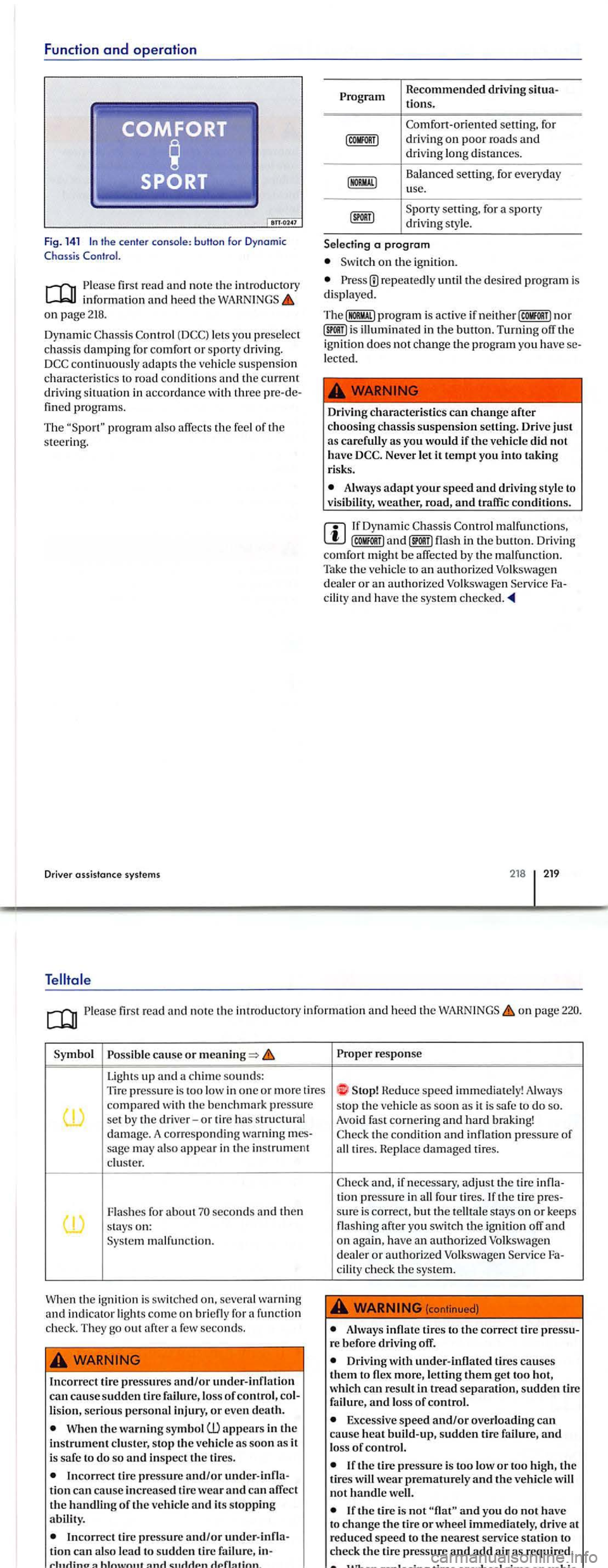
Function and operation
Fig. 141 In the cen te r co nsole : b uHon fo r Dynomic C hoss is
Please read and note th e introductory inf ormati on and hee d t he on page 218.
D ynamic C hassis Control lets you prese lec t
chassi s dam ping for comfo rt or sporty driving .
pro grams.
T he
program also affec ts th e feel of the steering .
Driver assis tanc e systems
Program R
ecommended driving
Comfort- oriented setting, for driving on poor roa ds and driving lon g di sta nces .
Balanced
setting, for everyday
u se.
a program
o n th e ignition.
re p ea te dl y th e des ired progra m is
disp laye d.
Th e
nor illumin ated in the button. Turning off the
i g nition does no t chan ge the program you have lec ted.
Driv ing characteristics can
change after choosing chassis suspension setting. Drive just as carefully as you would if the vehicle did not
h ave Neve r let it tempt you into takin g
risks.
Always adapt your speed and driving style to
visibil and traffic condit ions.
malfunctions , flash in the button. Driving comfo rt might be affec te d b y th e malfunction. Tak e th e ve hicl e to an authorized Volk swage n
d ea ler or an authorize d Volkswa gen
218 219
Please read and note the introdu ctory information and h eed the WARNINGS on page
Poss ible cause or
Lights up and a chime sounds: Tire pressure is too in one o r more tires compa re d wi th th e ben chmark press ure
se t by the driver-or ti re has stru ctural
damage. A co rre spo ndi ng warning
sa ge may also app ear in the instrument cluster.
Fla s hes for abo ut seconds and then stay s on: malfun ction.
W h
en the ignition i s s witched on, severa l warning
a nd ind icato r light s come on briefly fo r funct ion
c h ec k. Th ey go out after a few seco nds.
Incorrec t lire pressures and/or under- inflati on can cause sudden tire failure , loss of control , lisio n, seriou s personal injury, o r even death.
When the warning symb ol
In correc t tir e pressure a nd/or tio n can ca use incre a se d tir e wear and ca n affe ct the handling of th e ve hicle and its stoppin g
Incor rec t tir e pressure and/or ti o n can also lead t o sudden tir e fa ilu re,
Proper response
Heduc e speed imm ediately! Always
s t
op th e vehicle as soon as it is safe do so . Avoid fas t cornerin g and hard braking!
tion press ure in all four tires. If th e tir e
cilit y c heck the sys tem.
(continued)
Always inflate tires to the correct tire re befor e drivin g off .
Driv in g with under-inflat ed tire s causes them to flex more, letting the m get too hot,
which can
Excessive speed and/or over loading can
ca use heat build -up, sudden tire failure , and lo ss of control.
If the tire pressure is too low or too high , th e tires wear prematurely and the vehicl e will
not handl e we ll.
If the tire is not and yo u d o no t h ave
t o ch an ge the tire or whee l immediat ely , drive a t
reduced spee d to the nearest serv ice station to
c h eck th e tir e pressure and add
Page 221 of 541
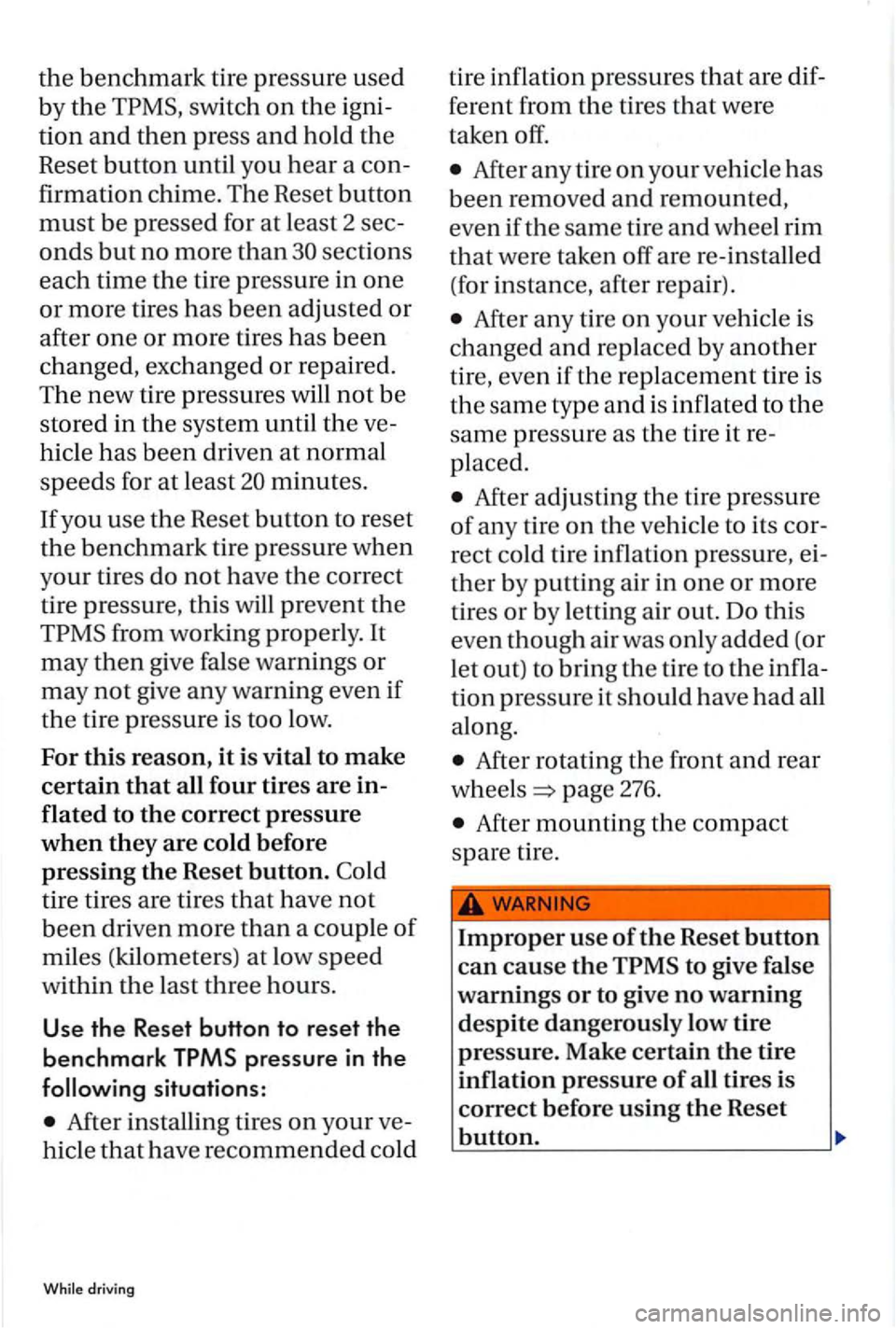
the benchmark tire pressure used
b y
the swi tch on the igni
tion
and then press and hold the
Reset button until you hear a con
firmation chime. The Reset button
must be pressed for at least 2 sec
onds but no more than sect ions
each time
the tire pressure in one
or more tire s has bee n adjusted or
after
one or more tires has been
changed, exchanged or r
epaired.
The new tire pressures will not be
st
ore d in the system until the ve
hicle has b
een driven at normal
s p eeds for
at leas t minutes.
If you use the Reset button to reset
the ben chmark tire pressure when
yo
ur tires do not have the corre ct
t ir e pressure, this
will prevent the
After installin g tires on your ve
hicle
that h ave recom mended co ld
driving
tire infl ation pressures that are dif
ferent from the tires that were
taken off.
After any tire on you r ve hicl e has
b
een removed and remounted,
even if t he sa me tire
and w hee l rim
that were taken off are re-insta ll ed
(for instance, after repair).
After a ny tire on you r veh icle is
changed
and r ep lace d by another
tire, even if th e rep lace me
nt tire is
th e
same type and is inflated to the
same press ure as the tir e it re
pl ace d.
After adjusting the tire pressure
of an y tire on the ve hicl e
to its cor
rect cold tire in flation pressure, ei
ther by putting air in one or more
tires
or by let tin g air out. Do this
even though air was o
nly added (or
let out)
to bring the tir e to the infl a
tion pressure it should have had all
along .
After rotating the front and rear
w he els
page 276.
After mounting th e compact
s pare tir
e.
Improper use of the Reset button
can cause the to give false
warnings
or to give no warning
d espite dangerously low tire
pressure. Make certain
the tire
inflation pressure
of all tires is
correct before using
the Reset
button.
Page 225 of 541

-- - -
Fig. 14 3
Fig. 144
first read and no te th e int rod uctory informatio n and heed th e on page 226. c
ato
r lig h t illum in a tes in the butto n. T o switch o ff
a fun ction, press the button again .
Th e
in a particular butto n up to show th at the function is acti va te d . the corresponding button to swit ch a function on or off.
Regul ator knob
Temperature
F a n
...
page 145, and C lim atronic 144 .
Heating sys tem, Climatic: Turn kn ob to set the desire d t emperature.
Climatronic: Left a nd rig h t sides of the ve hicl e can be set to diff erent te mperatu res. Turn th e reg ulator kno b to set the des ired t emperature. The te mpera tu re is dis pl aye d on the
o ut er r in g.
H e
ating sys te m , Climatic: Fan and swit ch ed off, 4: Highest fan speed .
C lim atronic: The speed of the fa n i s autom atically a dju sted d ep ending on th e ve hicle
s peed in o rd er t o avoid unnecessary noise . T he fan can also be adj usted
Page 233 of 541
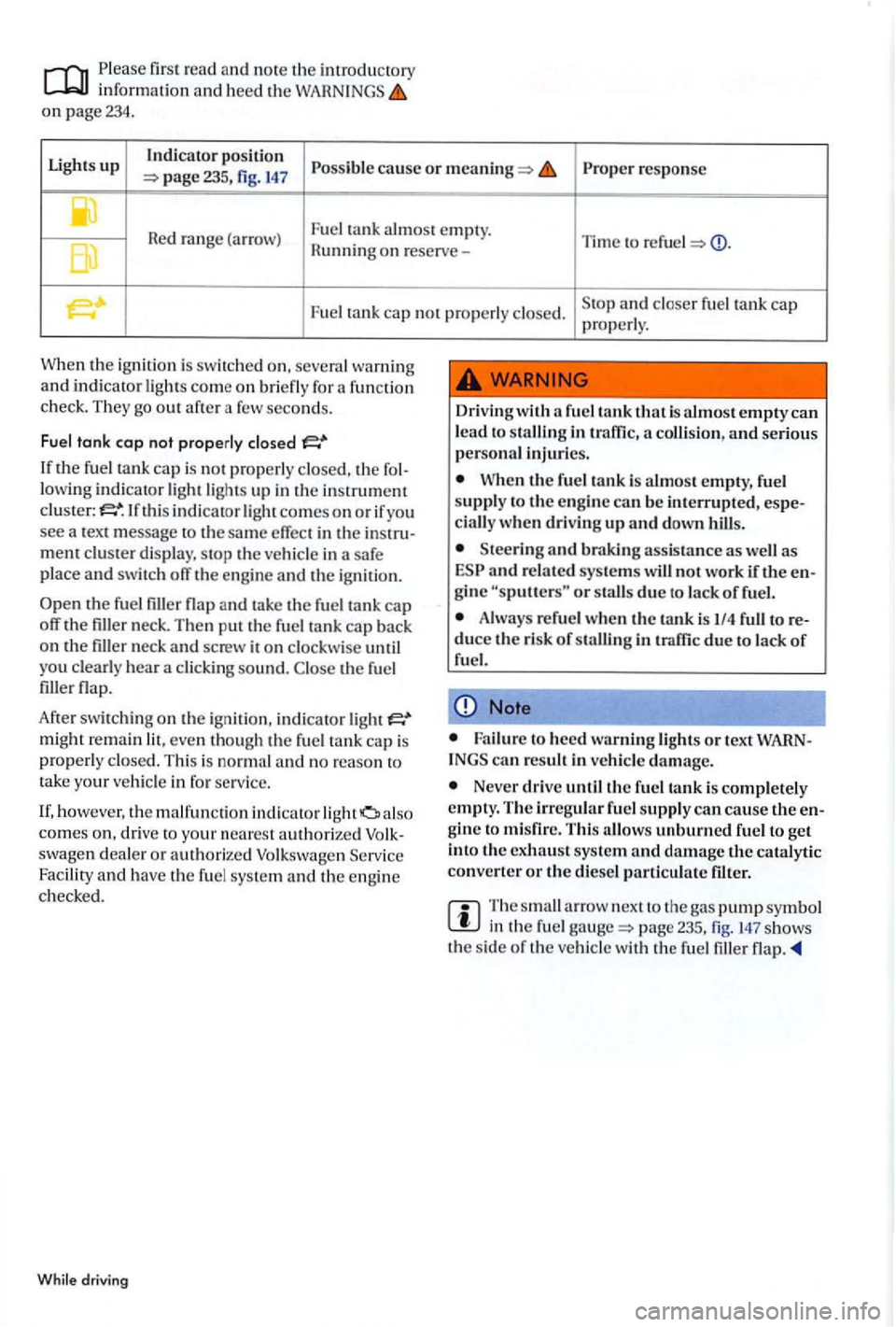
information and heed the WAHNINGS on page 234.
Lights
up Indicator pos itio n response 235, fig. 147
Hunning on reserve-
Fu el tank cap not pro perly closed. properly.
When the ignition is switched
a few seconds.
Fuel tank cap not properly
indicator ligh t comes on or if yo u see a tex t m essage to the same effec t in the in strument clu ste r d is play , stop the ve hicl e in a safe
p lace and switch ofT the en g ine and the ig n ition.
might remain even tho ugh the fu el t ank cap is properl y closed. This is no rm al and n o re ason to take your vehicl e in for se rvic e.
however, th e m alfun ctio n indicator light driv e to yo ur neares t authorized swagen dealer or authorize d Volkswage n Serv ice Facility and have fuel sys tem and the engine checked.
While driving
Driving with a fu el tank that is almost empty can
lead t o s tallin g in traffic, a co llisio n, and seriou s
p ersonal injuries.
W hen the fu el t ank is almost empty, fuel
supply to the engine can b e interrupted, especiall y w he n driving up and d ow n hill s.
Steerin g and braking assist ance a s we ll as and re lated syste ms w ill not work if the en
gine or s talls due to lack of fuel.
Always refuel w hen the tank is 1/4 full to re duce the risk of sta ll in g in traffic due to lack of fuel.
Note
----------------------~ Failure to heed warning lights or t ext WARN-can result in veh icle damage.
Never drive until the fuel tank i s com ple te ly
empty. The irregula r fu el supply can cause the e ngine to misfire. This allows unburned fuel t o ge t into the exhau st syste m and damage the cata lyti c
co nverter or the diesel p arti culate filt er.
The small next to the gas pump symbol in the fuel page fig. shows
th e sid e of the ve hicl e w ith the fuel filler flap.